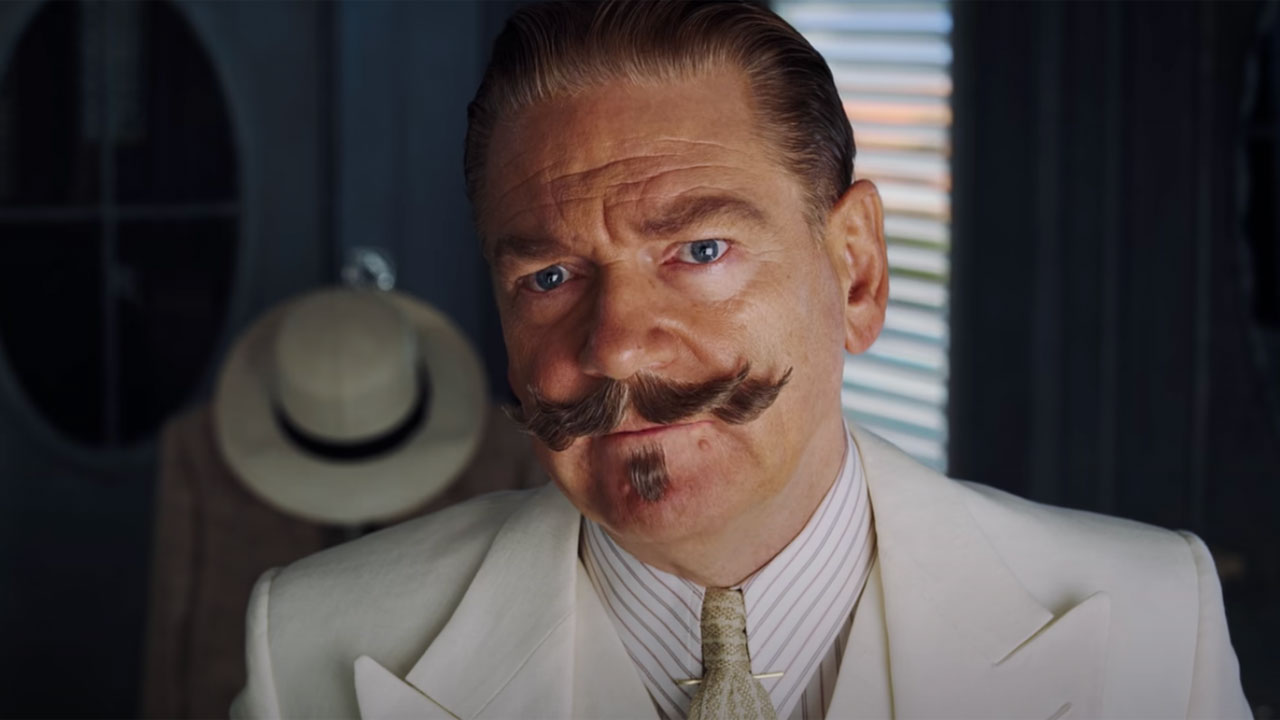Hercule Poirot’s Mustache Gets An Origin Story In Death On The Nile, And It’s Extremely Satisfying
Kenneth Branagh's Hercule Poirot is not the detective from fiction.

There are spoilers in this article, though not about the murderous and dastardly plot itself. Your mileage with these spoilers in advance of seeing the film may vary.
Hercule Poirot’s mustache has had many famous iterations over the years, from Albert Finney’s neat take on the ‘stache, to David Suchet’s much more finicky and perfectly sculpted look. Across two movies, Kenneth Branagh’s look has been the brashest and most masculine of the three, taking over a large portion of his face. Now, we know why, as Death on the Nile actually gives Branagh’s Poirot a mustache origin story.
In its opening scene, Death on the Nile strays furthest from Agatha Christie’s source material. We’re taken as viewers to the trenches of World War 1, where Hercule Poirot is a much younger man and, in fact, a much younger man with no mustache. He’s also deeply interested in the details, even at this point, and his success at simply paying attention helps his fellow men to cross No Man’s Land and mount a successful attack.
They gain victory on the other side and all seems to be well when Poirot’s (also mustachioed) Captain doesn’t think before he steps and accidentally hits a tripwire, leading to his death. Poirot is nearby when this happens and the shrapnel from the explosion cuts up his face. Later, we learn that Poirot is wooing a woman, who visits him in the hospital though is in a sour mood. Unabashedly, she shares her love and cheers him up, telling him he’ll simply have to grow a mustache and that she loves him anyway! And this is where the origin story begins, though there’s more to the tale to come.
In Agatha Christie’s novels, Poirot is very finicky about the state of his facial hair. At one point in her writings we learn he uses “curling tongs” to land the notable shape. At another point, it’s warm out and Hercule Poirot laments his mustaches were becoming “limp.” But there is some evidence for a large mustache, particularly in Murder on the Orient Express, in which he has trouble with soup. It’s only fitting then that that Murder on the Orient Express was where a new generation of fans are introduced to Hercule Poirot and this unwieldy mustache.
This version of Poirot seems to have take that note and run with it. This Hercule Poirot still has a memorable mustache, and perhaps even a great one, but in Death in the Nile this Poirot is less vain about that mustache. It is there to conceal more than anything else.
Of course, this version of the famous Belgian detective may not be exactly the same as other versions, but one thing Hercule Poirot always is is a bachelor, and Death On the Nile does not change those beats. As the twisted murder plot unfolds, we learn from Poirot that the love of his life, the woman who stood by him after his face was rent apart, died trying to see him while he was still recuperating in the hospital at Christmas. Afterward, Poirot did not return home to live a quiet life as a farmer. He grew a mustache; he concealed his scars; he became a great detective of some fame.
Your Daily Blend of Entertainment News
Lest you think Kenneth Branagh’s mustache is less “fastidious” than that of Suchet or even John Malkovich, who also occupied the role for TV, the director of Murder on the Orient Express and Death on the Nile did say the Hercule Poirot facial hair takes a lot of time to get right.
The tip of the mustache had to be this many inches from the ear lobe, this many inches up from the chin-line, this close to the nose. There was a series of strings, and rulers, and everything, that were put all over my face every time the mustache went on that were absolutely Poirot-ian in their fastidiousness.
While it may be bushier and bolder than what Agatha Christie considered in her own written works, I daresay what Kenneth Branagh achieved in this addition to the original tale is emotionally satisfying. Besides, it offers one other cool tie-in to the director’s career, in that he employed black and white footage for the World War I scenes, which is a tact he also used in the awards darling film Belfast that came out in 2021. (Our Belfast review.) These additions are noteworthy along with some of the other changes from the novel.
What Kenneth Branagh has brought to life on the big screen is obviously not the version of Poirot Agatha Christie wrote. There’s too much action that Poirot is involved in and he frankly doesn’t look the part. But I’m personally pleased for the trailer and movie to bring something a little newer, a little more thrilling, a little more emotionally resonating for the big screen. I’m not sure that one can improve on the original version, or should even try, but I do think there's room to keep making these movies, and I'm happy they are trying something new.
Now if only I knew what David Suchet himself thinks...

Jessica Rawden is Managing Editor at CinemaBlend. She’s been kicking out news stories since 2007 and joined the full-time staff in 2014. She oversees news content, hiring and training for the site, and her areas of expertise include theme parks, rom-coms, Hallmark (particularly Christmas movie season), reality TV, celebrity interviews and primetime. She loves a good animated movie. Jessica has a Masters in Library Science degree from Indiana University, and used to be found behind a reference desk most definitely not shushing people. She now uses those skills in researching and tracking down information in very different ways.
